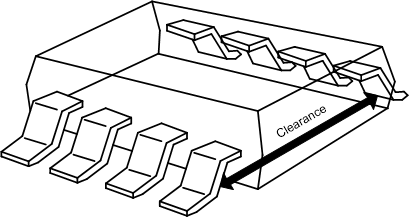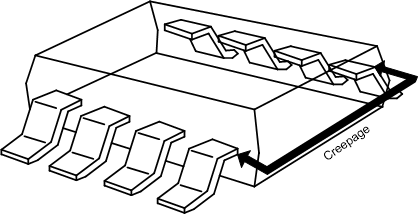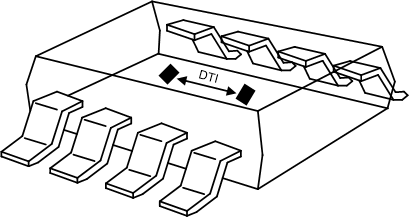SLLA563 June 2021 ISO1042 , ISO1042-Q1 , ISO1044 , ISO1050 , ISO1176 , ISO1176T , ISO1410 , ISO1412 , ISO1430 , ISO1432 , ISO1450 , ISO1452 , ISO15 , ISO1500 , ISO1540 , ISO1540-Q1 , ISO1541 , ISO1541-Q1 , ISO1640 , ISO1640-Q1 , ISO1641 , ISO3080 , ISO3082 , ISO3086 , ISO3086T , ISO3088 , ISO35 , ISO35T , ISO6720 , ISO6720-Q1 , ISO6721 , ISO6721-Q1 , ISO6731 , ISO6731-Q1 , ISO6740 , ISO6740-Q1 , ISO6741 , ISO6741-Q1 , ISO6742 , ISO6742-Q1 , ISO7021 , ISO7041 , ISO7131CC , ISO7140CC , ISO7140FCC , ISO7141CC , ISO7141FCC , ISO7142CC , ISO7142CC-Q1 , ISO721 , ISO721-Q1 , ISO721M , ISO721M-EP , ISO722 , ISO722-Q1 , ISO7220A , ISO7220A-Q1 , ISO7220B , ISO7220C , ISO7220M , ISO7221A , ISO7221A-Q1 , ISO7221B , ISO7221C , ISO7221C-HT , ISO7221C-Q1 , ISO7221M , ISO722M , ISO7230C , ISO7230M , ISO7231C , ISO7231C-Q1 , ISO7231M , ISO7240C , ISO7240CF , ISO7240CF-Q1 , ISO7240M , ISO7241A-EP , ISO7241C , ISO7241C-Q1 , ISO7241M , ISO7242C , ISO7242C-Q1 , ISO7242M , ISO7310-Q1 , ISO7310C , ISO7310FC , ISO7320-Q1 , ISO7320C , ISO7320FC , ISO7321-Q1 , ISO7321C , ISO7321FC , ISO7330-Q1 , ISO7330C , ISO7330FC , ISO7331-Q1 , ISO7331C , ISO7331FC , ISO7340-Q1 , ISO7340C , ISO7340FC , ISO7341-Q1 , ISO7341C , ISO7341FC , ISO7342-Q1 , ISO7342C , ISO7342FC , ISO7420 , ISO7420E , ISO7420FCC , ISO7420FE , ISO7420M , ISO7421 , ISO7421-EP , ISO7421A-Q1 , ISO7421E , ISO7421E-Q1 , ISO7421FE , ISO7520C , ISO7521C , ISO7631FC , ISO7631FM , ISO7640FM , ISO7641FC , ISO7641FM , ISO7710 , ISO7710-Q1 , ISO7720 , ISO7720-Q1 , ISO7721 , ISO7721-Q1 , ISO7730 , ISO7730-Q1 , ISO7731 , ISO7731-Q1 , ISO7740 , ISO7740-Q1 , ISO7741 , ISO7741-Q1 , ISO7741E-Q1 , ISO7742 , ISO7742-Q1 , ISO7760 , ISO7760-Q1 , ISO7761 , ISO7761-Q1 , ISO7762 , ISO7762-Q1 , ISO7763 , ISO7763-Q1 , ISO7810 , ISO7820 , ISO7820LL , ISO7821 , ISO7821LL , ISO7821LLS , ISO7830 , ISO7831 , ISO7840 , ISO7841 , ISO7842 , ISOW1044 , ISOW1412 , ISOW1432 , ISOW7740 , ISOW7741 , ISOW7742 , ISOW7743 , ISOW7744 , ISOW7821 , ISOW7840 , ISOW7841 , ISOW7841A-Q1 , ISOW7842 , ISOW7843 , ISOW7844
1 Introduction
When it comes to high voltage safety certifications, the following three distances are of utmost importance to determine insulation ratings of semiconductor components: clearance, creepage, and DTI. Clearance is the shortest distance in air between two conductive parts and creepage is the shortest distance along the surface of a solid insulation material between two conductive parts across the isolation barrier. DTI, on the other hand, is the shortest distance within an insulating material interposed between two conductive parts. In other words, DTI is the distance inside a solid insulation whereas clearance and creepage are distances outside the solid insulation. See Figure 1-1 for typical depiction of clearance, creepage, and DTI.
 |
 |
 |
There are a lot of misconceptions in the market about DTI requirements of digital isolators. These misconceptions arise due to confusion caused by the complexity of the international end-equipment standards and multiple clauses of these standards that deal with DTI requirements and exceptions. Some equipment manufacturers believe that the large DTI requirements outlined in certain clauses of their equipment standards strictly apply to digital isolators; this is simply not true. Digital isolators use a much thinner, yet more robust, insulation material when compared to optocouplers and other legacy isolators, and therefore many international standards have different test criteria for isolators with thin DTI compared to legacy isolators.